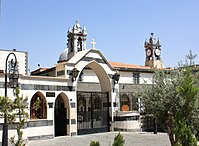Melkite Greek Catholic Church | |
|---|---|
| Arabic: كنيسة الروم الملكيين الكاثوليك | |
 | |
| Type | Antiochian |
| Classification | Eastern Catholic |
| Orientation | Melkite |
| Theology | Catholic Theology |
| Polity | Episcopal |
| Pope | Francis |
| Primate | Patriarch Youssef Absi |
| Cyril VI Tanas |
| Region | Egypt, Palestine, Israel, Jordan, Lebanon, Sudan, Syria, Turkey, Iraq, Argentina, Australia, Belgium, Brazil, Canada, France, Mexico, New Zealand, United States, United Kingdom, Venezuela and Sweden |
| Language |
|
| Liturgy | Byzantine Rite |
| Headquarters | Cathedral of Our Lady of the Dormition, Damascus, Syria |
| Founder | Apostles Peter and Paul, by Melkite tradition |
| Origin | 1724, with tradition tracing its origin to the 1st-century Church of Antioch[1] |
| Branched from | Church of Antioch[1] |
| Members | 1,568,239[2] |
| Other name(s) |
|
| Official website | melkitepat.org |
The Melkite Greek Catholic Church,[a] or Melkite Byzantine Catholic Church, is an Eastern Catholic church in full communion with the Holy See as part of the worldwide Catholic Church. Its chief pastor is Patriarch Youssef Absi, headquartered at the Cathedral of Our Lady of the Dormition in Damascus, Syria. The Melkites, who are Byzantine Rite Catholics, trace their history to the early Christians of Antioch, formerly part of Syria and now in Turkey, of the 1st century AD, where Christianity was introduced by Saint Peter.[3]
The Melkite Church, like many other Eastern Catholic particular churches, shares the Byzantine Rite with the Greek Orthodox Church of Antioch and other Eastern Orthodox churches. It is mainly centered in Syria, Lebanon, Jordan, Israel and Palestine.[4] Melkite Greek Catholics are present, however, throughout the world by migration due to persecution of Christians. Outside the Near East, the Melkite Church has also grown through intermarriage with, and the conversion of, people of various ethnic heritages as well as transritualism. At present there is a worldwide membership of approximately 1.6 million.[2][5]
While the Melkite Catholic Church's Byzantine liturgical traditions are shared with those of Eastern Orthodoxy, the church has officially been part of the Catholic Church since re-entering communion with the Holy See under Patriarch Cyril VI Tanas in 1724. Those who rejected this move formed the extant Greek Orthodox Church of Antioch.[6]
- ^ a b Schaefer, Francis James [at Wikisource] (1913). . In Herbermann, Charles (ed.). Catholic Encyclopedia. New York: Robert Appleton Company.
- ^ a b Roberson, Ronald G. "The Eastern Catholic Churches 2017" (PDF). Catholic Near East Welfare Association. Archived from the original (PDF) on 24 October 2018. Retrieved 19 May 2019. Information sourced from Annuario Pontificio 2017 edition
- ^ "The Melkites". Eparchy of Newton : Melkite Greek Catholic Church. 14 August 2010. Archived from the original on 7 December 2020. Retrieved 23 March 2019.
- ^ "Church History". Melkite Greek Catholic Patriarchate. Archived from the original on 5 March 2007.
- ^ Faulk 2007, pp. 9–10.
- ^ Parry et al. 1999, p. 312.
Cite error: There are <ref group=lower-alpha> tags or {{efn}} templates on this page, but the references will not show without a {{reflist|group=lower-alpha}} template or {{notelist}} template (see the help page).